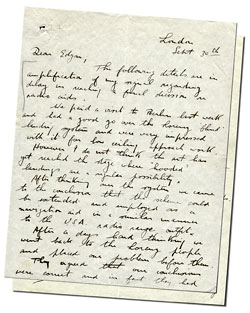The Genesis of the 'Lorenz' Radio Range System

In the Civil Aviation Historical Society's archive, among the E.C.Johnston Collection, is a hand-written letter from C.S.Wiggins to CCA E.C.Johnston, the text of which is reproduced below.
One of
the most important documents in the technical development of Australian
civil aviation, it tells of the germ of an idea to adapt the German Lorenz
33 Mc/s 'blind' landing aid for use as Australia's first standard radio
navigation beacon. This is indeed what eventually happened, and the Radio
Range was in operational use from 1938 to 1953.
A copy of the actual letter can be downloaded by clicking on the image at left (1.5 MB .pdf file)
London
Sept 30th [1935]
Dear Edgar [Johnston],
The following details are in amplification of my original regarding delay
in reaching a final decision re radio aids.
We paid a visit to Berlin last week and had a good go over the Lorenz "blind" landing system and were very impressed with it for low ceiling approach work. However I do not think the art has yet reached the stage where "hooded" landings are a regular possibility.
After thinking over the system we came to the conclusion that the scheme could be extended and employed as a navigation aid in a similar manner to the U.S.A. radio range outfit.
After a day's hard thinking we went back to the Lorenz people and placed our problem before them. They agreed that our conclusions were correct and in fact they had placed a proposal before the Swedish government for an air route organization working on those lines.
The advantages were so great that we felt that the whole matter required very considerable and detailed consideration and have arranged for the Lorenz people to go into the matter in detail. Their engineers are now working on the job and are to give us the necessary information as soon as available.
Broadly speaking the advantages are:
1/
Freedom from atmospheric interference
2/ Absence from multiple courses
3/ Provision of blind or low ceiling landing aids
4/ All advantages of U.S.A. radio range and none of its disadvantages
5/ Economy and flexibility due to very simple and cheap aerial system
employed.
The disadvantages that are known are:
1/
Limited range - say approx. 100 miles
2/ Greater attention necessary to shielding of aircraft ignition and electrical
gear.
Of these disadvantages the range is no more than could be obtained with the U.S.A. system and is sufficient for the majority of cases. Regarding the second, this is simply a matter of maintenance and is neither costly nor impossible - neither is it impracticable.
Regarding the advantages, 1/ is a well known fact, 2/ is borne out by the installation at Zurich where no trouble is experienced and is due to the fact that ultra-high frequencies are absorbed to a greater degree than lower frequencies and there is thus less reflection. The other advantages are just facts which examination of the system has disclosed.
We are still working on high frequency D/F for Darwin and hope to get this finalized in the next two weeks but it is very hard to obtain information as your experience must have proved.
I think that covers the present position and am hoping that an early decision can be reached as I am getting fed up with the continual hunting for the truth. Winter is closing in rapidly and I long to get on our way back home.
Regards to Dave [Ross], Mc [A R McComb], Stan [Coles] and Co.
Yours,
Back to the story of the 33 Mc 'Lorenz Radio Range system
Back to the Communications & Navigation index page